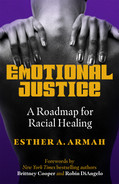![]()
Foreword
Dr. Robin DiAngelo
I am white, and I have been engaged in educating other white people on systemic racism for over twenty years. This education requires challenging the ideologies that uphold racism, which include color blindness, meritocracy, and individualism. Yet challenging these ideologies has very real material consequences as white people react with intense emotions.
There are many reasons why white people are so defensive about the suggestion that we benefit from, and are complicit in, a racist system, including the following:
• Social taboos against talking openly about race
• The racist = bad / not racist = good binary
• Fears of people of color
• Our view of ourselves as objective individuals
• Our guilt and knowledge that there is more going on than we can or will admit to
Our emotional reactions when these norms are challenged may be automatic, but they are not natural. We have been deeply conditioned into them, and they function to protect the racist status quo. White emotionality is the connective tissue of systemic racism. When I first heard Esther Armah explain Emotional Justice, I knew that this was the missing piece: even though white people have the concepts, it is our emotional reactions—our false sense of scarcity and threat—that continually holds racism in place and keeps us from acting in solidarity.
We tend to see emotions as emerging unbidden from some internal and private place. And because we see emotions this way, we tend to take them at face value. Even so, not all emotions are sanctioned; the legitimacy they are granted varies based on why, when, and how they are expressed and who is expressing them. For example, white men can express anger and be seen as powerful leaders, whereas Black men expressing anger are seen as threatening. White women expressing anger are seen as shrill, whereas Black women are seen as aggressive and out of control. In other words, we are conditioned to express and interpret emotions in particular ways; they are not purely natural or unique to each individual. Emotions have social consequences, and they invoke behaviors that are then acted out and that impact others collectively. Emotional Justice reframes emotions in ways that make visible the racial and political context in which they emerge and gives us the emotional language and literacy we need if we are to end racism.
A key aspect of whiteness is that it does not require white people to develop the emotional capacity to withstand racial discomfort, and certainly not to think politically about our emotions. The result is the punitive power of white fragility, which functions as a form of social control and racial policing. White emotionality structures the everyday realities of Black people in ways that have material impacts. Emotional Justice offers white people a powerful framework through which to understand racism at the emotional level and develop the stamina to free ourselves. In so doing, Armah moves us from our heads to our hearts.
If we are to authentically challenge systemic racism, we must begin to understand the sociopolitical nature of emotions. If we could end racism from a purely intellectual place, we would have done so. In these pages, Esther Armah, with elegance and precision, offers us a way forward. Emotional Justice recognizes the sociopolitical dimensions of emotionality and seeks to heal the trauma that—left unaddressed—keeps us attached to white supremacy. For white people, healing this trauma entails the appropriate expression of loss, grief, and rage. These are feelings that we have either collectively sublimated or acted out as white fragility. Here, Armah illuminates how we can transform historical trauma into liberatory action, and in so doing, heal ourselves and the larger structures in which we feel and act.
Dr. Robin DiAngelo, author of the
New York Times best seller, White Fragility
